-
United States -
United Kingdom -
India -
France -
Deutschland -
Italia -
日本 -
대한민국 -
中国 -
台灣
-
Ansysは、シミュレーションエンジニアリングソフトウェアを学生に無償で提供することで、未来を拓く学生たちの助けとなることを目指しています。
-
Ansysは、シミュレーションエンジニアリングソフトウェアを学生に無償で提供することで、未来を拓く学生たちの助けとなることを目指しています。
-
Ansysは、シミュレーションエンジニアリングソフトウェアを学生に無償で提供することで、未来を拓く学生たちの助けとなることを目指しています。
ANSYS BLOG
November 10, 2023
High Schooler Realizes Computational Engineering Passion During F1 in Schools Competition
Most students head to college unsure which classes to take, major to pursue, or career path to follow. Typically, college is one of the first places where students can dive deeper into subject matter, gaining the hands-on experience needed to understand their likes, dislikes, strengths, or weaknesses. But what if students developed this insight in high school? They would likely enter college with a competitive edge, richer background, and clearer academic plan. At least that’s the case for recent high school graduate, Aryaman Bansal.
Bansal participated in F1 in Schools competitions in India throughout high school. F1 in Schools is the only global multidisciplinary challenge in which teams of students integrate computer-aided design (CAD) and computer-aided manufacturing (CAM) software to design, manufacture, and race miniature, compressed-air powered cars made from F1 model block. After three years of competing in the Indian Nationals, Bansal participated in the 2022 F1 in Schools World Finals as a senior and applied Ansys simulation to the F1 challenge for the first time.
Aside from the thrill of international competition, Bansal was most impressed by the computational fluid dynamics (CFD) experience he obtained as the team’s sole engineer. As part of the Ansys Academic Program, Ansys provides access to free simulation commercial software for student teams in competition. As a result, Bansal gained firsthand experience with computational methods, developed a passion for computational engineering, and plans to pursue the field at university this winter.

Aryaman Bansal, high school graduate, aspiring computational engineer
Getting into the Flow with CFD
To compete in the 2022 F1 in Schools World Finals, Bansal and a group of five other engineering enthusiasts from different schools formed the Helios Racing team, its name inspired by the Greek sun god.
They spent approximately nine months completing their car, Aethon — named in another nod to Greek mythology — from design conceptualization to manufacturing. As the team’s sole engineer, Bansal worked exclusively on Aethon’s development using Ansys simulation. At the time, Bansal attended the Shri Ram School in Moulsari, India.
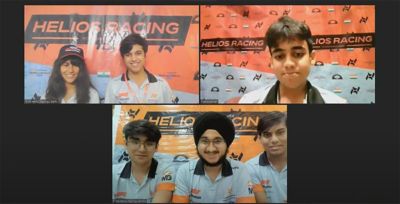
Bansal and five other engineering enthusiasts formed Helios Racing in 2022 to compete in the F1 in Schools World Finals.
“Before being sponsored by Ansys, I had used other CFD solvers that provided inconsistent and therefore unreliable data,” he says. “This inconsistency led to misguided engineering decisions based on that data and upon rerunning those simulations with Ansys, I realized that many of the decisions had actually worsened the car’s performance. Ansys CFD solvers completely eliminated this problem.”
For the global competition, Bansal completed all CFD simulations using Ansys Discovery, a 3D design software tool that combines interactive modeling and simulation, enabling him to address critical design challenges earlier in the design process. Virtual modeling is a key component of the competition, which challenges students to integrate CAD/CAE software into building miniature, air-compressed cars that will race on the official 20-meter F1 in Schools competition track at the famed Silverstone Circuit in England.
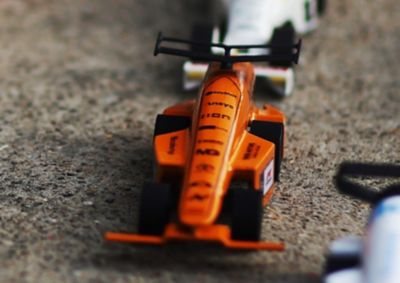
Helios Racing’s miniature, compressed-air powered car, Aethon.
Engineering Tiny Yet Mighty Models
Miniature is a fair description. Aethon’s specs were roughly 210 millimeters in length, 85 millimeters in width, and 65 millimeters in height — approximately 8 inches, 3 inches, and 2.5 inches, respectively. But don’t let its size fool you. Aethon consisted of several components, including a chassis, front wing, rear wing, and two wheel support structures (one for the front wheels and another for the rear wheels).

Bansal’s team, Helios Racing, manufactured multiple models of Aethon ahead of the 2022 F1 in Schools competition.
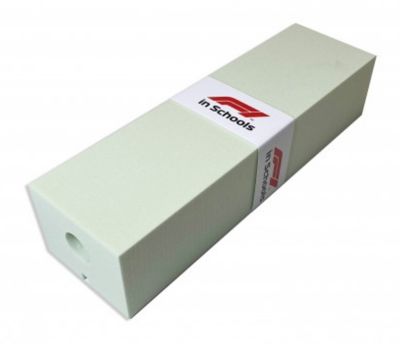
F1 in Schools competition organizers require students to build their car chassis using a polyurethane model block, which they supply.
Students can choose their own materials for the front wing, rear wing, and wheel support structures so Bansal and his team selected materials such as Nylon 12, ceramic, and stainless steel for these parts. However, teams are required to create the car chassis using a polyurethane model block supplied by competition organizers. The model block is manufactured in a computer numerical control (CNC) machine to achieve the desired chassis shape and then the teams attach the remaining car components to the model block using different assembly methods such as super glue or friction fits.
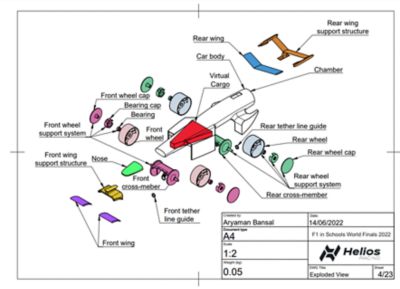
A drawing of Aethon illustrates car parts and components to demonstrate compliance with technical specifications. The chassis is indicated as the car body
Of course, aside from the structural savvy it takes to build a car this size teams must also develop its aerodynamic components, which pose more challenges than a standard internal combustion engine-based car. Compressed-air cars are powered by pressure vessels filled with compressed air and rely on a thermodynamic process.
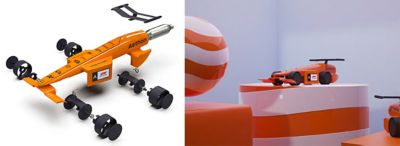
Renderings of Aethon show the car disassembled (left) and fully assembled (right).
“Ansys proved to be extremely valuable in the engineering process for several reasons,” says Bansal, noting some of the additional challenges, including power generation.
For starters, every car in the competition is powered by the same air canisters supplied by F1. This means most of the car’s performance depends on its aerodynamic and mechanical efficiency to utilize the gas canister’s energy. Hence, engineers are limited in what they can do to enhance power generation. In addition, all teams must adhere to stringent technical regulations regarding car design.
“Consequently, F1 in Schools cars featured complex components such as the front and rear wings, which needed to be meticulously crafted to ensure a smooth airflow over the entire car body,” he says. “This was in contrast to standard road cars, which have a single-component structure with one surface blending across the entire car body. Furthermore, given the small size of an F1 in Schools car, Ansys CFD simulations played a crucial role in visualizing the airflow using CFD simulation tools. This would have been impractical in real life as qualitative data from wind tunnels at such a small scale would have been highly unreliable.”
Discovery’s CFD capabilities, which are powered by the Ansys Fluent solver, allowed Bansal to understand, model, and analyze Aethon’s aerodynamic behavior. In addition, Discovery’s structural analysis capabilities enabled Bansal to construct mesh, test design ideas, and receive immediate insight on structural performance.
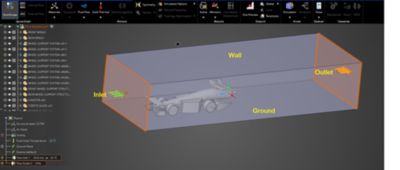
CAD model showing a car in a wind tunnel and applied boundary conditions.
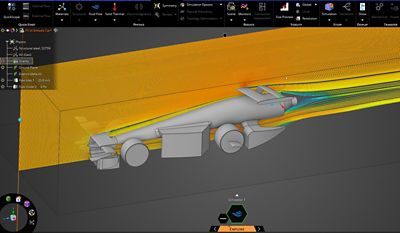
Airflow obtained around the vehicle in Ansys Discovery.
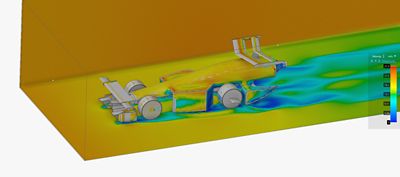
Velocity contours on the car are displayed after conducting a simulation.
Gearing up for the Future
The 2022 F1 in Schools World Finals four-day competition took place in July but all project elements, including the cars and technical documentation, were submitted months in advance for detailed examination. On the day of the competition, Helios Racing came in sixth place, winning one of the deciding “Knockout Championship” rounds. Additionally, the team was nominated for the “Best Engineered Car” and “Best Scrutineering” awards.
Still, for Bansal the real victory came upon discovering his passion for computational methods and engineering.
“Having experience with Ansys simulations greatly influenced my decision to pursue a career in computational engineering,” he says.
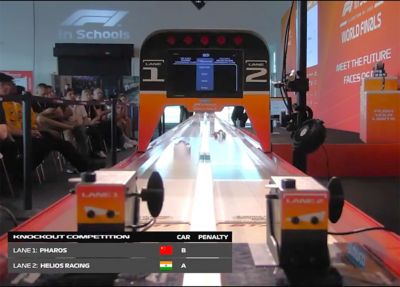
Helios Racing defeats team Pharos during the 2022 F1 in Schools World Finals Knockout Competition
“While using this software for various methods and gaining a deeper understanding of its workings, I came to appreciate the immense potential of computational tools like Ansys and how they can revolutionize problem-solving approaches across various industries.”
Likewise, his budding interests led him to the International Baccalaureate Diploma Program (IBDP), an internationally recognized educational program offered to students aged 16-19 at participating schools. As part of the program, students are required to write a mini research paper known as the extended essay. Participating in the May 2023 submission series, Bansal focused his essay on the aerodynamic effects of aircraft flying in formation and used 3D models of airplane wings to conduct CFD simulations in Discovery.
Bansal’s research indicated that formation flight could enhance fuel efficiency, supported by higher lift-to-drag ratios in formation versus individual wings. His paper achieved the highest attainable grade in the IBDP examination.
“The Ansys Academic Program played a pivotal role in both my F1 in Schools project and my research paper,” he says. “Similarly, in the case of my research paper, without access to Ansys CFD solutions, I would have had to abandon my research topic altogether. The entire methodology of my research relied on CFD simulations, and other solvers would not have produced reliable data to draw replicable conclusions.”
Bansal plans to pursue computational engineering at university in January 2024 and is confident his skills will benefit him in any field.
“Before I started using Ansys, I had no idea how much technology was shaping research and development in the engineering field worldwide,” he says. “I was particularly fascinated by the ingenious solutions these tools offered, such as creating complex geometries into meshes, and I felt a strong desire to contribute to this emerging technology and be part of the change in the engineering world. Currently, I am not limiting myself to any specific industry because I believe that computational methods hold potential in virtually every major industry. I believe my skills can be applied to contribute to the development of such tools in any of these fields.”
Learn more about the Ansys Academic Program. Explore Ansys’ tools firsthand by browsing free student software bundles.










